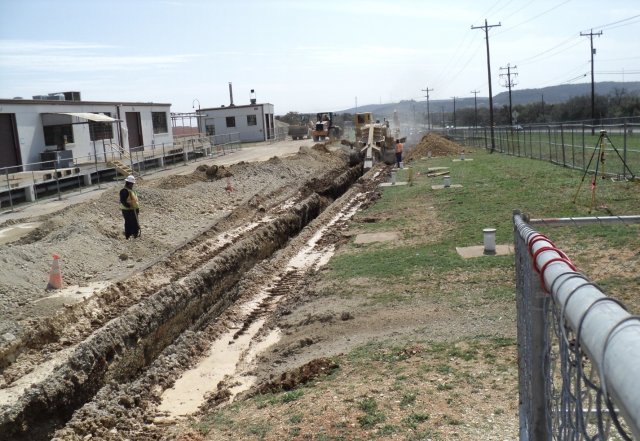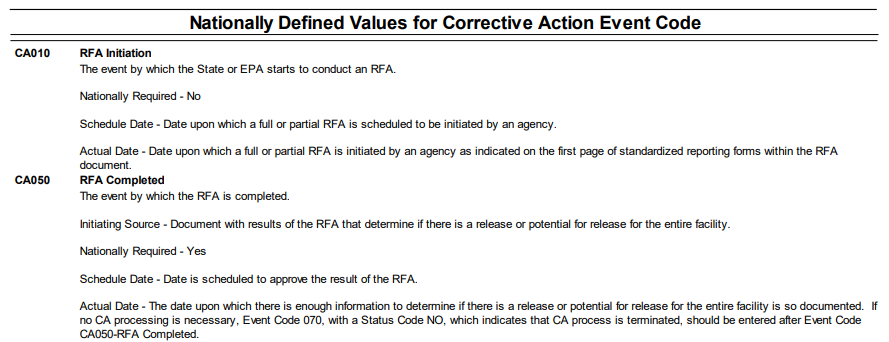Learn about Hazardous Waste Cleanups
On this page:
- What are Hazardous Waste Cleanups?
- What are Hazardous Waste Cleanup Facilities?
- The Hazardous Waste Cleanup Process
- Related Information
What are Hazardous Waste Cleanups?
Cleanup (known in the regulations as corrective action) is a requirement under the Resource Conservation and Recovery Act that facilities that treat, store or dispose of hazardous wastes investigate and clean up hazardous releases into soil, ground water, surface water and air. In 1984, Congress passed the Hazardous and Solid Waste Amendments, which granted EPA expanded authority to require cleanup at permitted and non-permitted treatment, storage and disposal facilities.
Rather than creating a rigid regulatory framework for hazardous waste cleanup, EPA developed guidance and policy documents to assist facilities conducting cleanups. Some of the resources are broad in scope, while others are more process or media specific.
Hazardous waste cleanup is principally implemented through the RCRA permits and orders. RCRA permits issued to TSDFs must include provisions for hazardous waste cleanup as well as financial assurance to cover the costs of implementing those cleanup measures. In additional to EPA, 44 states and territories are authorized to run the Hazardous Waste Cleanup Program. Hazardous waste cleanup is largely enforced through statutory authorities established by RCRA. Check out the Frequent Questions About Hazardous Waste Cleanups webpage.
What are Hazardous Waste Cleanup Facilities?
Hazardous waste cleanup facilities vary significantly. They include current and former chemical manufacturing plants, oil refineries, lead smelters, wood preservers, steel mills, commercial landfills, federal facilities, and a variety of other types of entities. Size, type and extent of contamination, media affected, environmental characteristics, and geology also differ greatly between facilities. Treatment, storage, and disposal facilities are generally brought into the hazardous waste cleanup process when:
- there is an identified release of hazardous waste or hazardous constituents, or
- when EPA is considering a treatment, storage and disposal facility RCRA permit application.
The Hazardous Waste Cleanup Program, comprised of EPA and its state and territorial partners, oversees almost 4,000 cleanups across the country, including many facilities with risks comparable to Superfund Sites. Information on these individual facilities is available from the Hazardous Waste Cleanup Programs Around the Nation webpage and in Cleanups in My Community.
The Hazardous Waste Cleanup Program works closely with facilities during the investigation and cleanup process.
Resources
- Learn how EPA measures progress at hazardous waste cleanup facilities.
- Gather facility-specific information from EPA's regional programs.
The Hazardous Waste Cleanup Process
The hazardous waste cleanup process focuses on results rather than specific steps, and is flexible, depending on site-specific conditions. A typical cleanup may include steps such as: initial site assessment, site characterization, interim actions, evaluation of remedial alternatives, and implementation of the selected remedy.
Because no one approach is likely to be appropriate for all hazardous waste cleanup facilities, these five elements should not be viewed as prescribed steps in the hazardous waste cleanup process. Instead, they serve as evaluations necessary to make good cleanup decisions within a flexible program. The five elements are described below in more detail. Additional elements of hazardous waste cleanup to keep in mind, and which are also described below, are tracking progress and long-term care.
Select the cleanup step to learn more about its function in the hazardous waste cleanup process. EPA provides links to guidance documents and other information to help the regulated community and program implementers learn about and enforce the hazardous waste cleanup process.
Initial Site Assessment
The first element in most cleanup programs is an initial site assessment. During the initial site assessment, state or EPA technicians require facilities to produce information on site conditions, releases, potential releases, and exposure pathways to determine whether a cleanup may be needed and to identify areas of potential concern. In the Hazardous Waste Cleanup Program, this step is commonly referred to as RCRA Facility Assessment. Overseeing agencies may also use initial site assessments to set relative priorities among facilities and allocate resources. EPA issued the Initial Site Assessment guidance to assist in this process.

Site Characterization
Before cleanup decisions can be made, some level of characterization is necessary to ascertain the nature and extent of contamination of a site and to gather information necessary to support selection and implementation of appropriate remedies. This step is often referred to as the RCRA Facility Investigation. A successful RFI will identify the presence, movement, fate, and risks associated with environmental contamination at a site and will explain the chemical and physical properties of the site likely to influence contamination migration and cleanup. Information collected during the RFI can be used by the owner or operator to formulate and implement appropriate corrective measures. Such corrective measures may range from a) stopping the release through the application of a source control technique to b) a full-scale cleanup of the affected area.
EPA’s Resource Conservation and Recovery Act (RCRA) Facility Investigation guidance, which is presented in four volumes below, provides guidance to regulatory agency personnel on overseeing owners or operators of hazardous waste management facilities in the conduct of the compliance monitoring phase of the Hazardous Waste Cleanup Program, the RFI:
- RFI Guidance Volume 1 (pdf) .
- RFI Guidance Volume 2 (pdf) .
- RFI Guidance Volume 3 (pdf) .
- RFI Guidance Volume 4 (pdf) .
Interim Actions
While site characterization is underway or before a final remedy is selected, hazardous waste cleanup facilities often need interim actions. Interim actions are used to control or abate ongoing risks to human health and the environment in advance of the final remedy selection. For example, actual or potential contamination of drinking water supplies may necessitate an interim action to provide alternative drinking water sources. EPA issued an Interim Corrective Action Guidance (pdf) to assist in this process.
Evaluation of Remedial Alternatives
Before choosing a cleanup approach, program implementers and facility owners or operators will typically analyze a range of alternatives and evaluate their advantages and disadvantages relative to facility-specific conditions. Such a study is called the Corrective Action Measures Study. EPA developed the Corrective Measures Study Guide (pdf) to help parties working on a hazardous waste cleanup through the following four tasks:
- Identification and development of the corrective measures alternatives.
- Evaluation of the corrective measures alternatives.
- Justification and recommendation of the corrective measures.
- Reports.
The purpose of the Corrective Measures Study is to develop and evaluate the hazardous waste cleanup alternatives and to recommend the corrective measures be taken at the facility.
Remedy Implementation
Remedy implementation typically involves detailed remedy design, remedy construction, remedy operation and maintenance and remedy completion plans. In the Hazardous Waste Cleanup Program, this step is often referred to as Corrective Measures Implementation. EPA issued Evaluation of Remedy Implementation documents to assist in this process.

Tracking Progress
This Corrective Action Event Code document (pdf) provides information on tracking cleanup progress at RCRA facilities. EPA developed a series of event codes for activities from the first facility assessment until the hazardous waste cleanup is terminated. These codes provide important information, such as when the state or EPA determines the remedy for a facility to achieve hazardous waste cleanup goals, as well as when the facility completes the remedy, and major hazardous waste cleanup milestones.

Long-Term Care
The Hazardous Waste Cleanup Program strives to ensure long-term protection after a facility cleanup has established institutional and engineering controls. This protects the integrity of the remedy by preventing or limiting exposure to remaining hazardous waste on the facility. EPA defines institutional controls as "non-engineered instruments, such as administrative and legal controls, that help to minimize the potential for human exposure to contamination and protect the integrity of the remedy." Such controls provide information and restrictions that help modify or guide human behavior at facilities and properties where hazardous wastes and contamination prevent unlimited use and unrestricted exposure. Common examples of institutional controls include permits and orders, zoning, building or excavation permits, well drilling prohibitions, deed notices, and easements and restrictive covenants. EPA developed the following Long-Term Care documents for identifying and selecting institutional controls at hazardous waste cleanups:
- Memo: Transmittal of Final Fact Sheet (pdf) .
- Fact Sheet: A Site Manager's Guide to Identifying, Evaluating and Selecting Institutional Controls at Superfund and RCRA Corrective Action Cleanups (pdf) .
- Ensuring Effective and Reliable Institutional Controls at RCRA Facilities (pdf) (347 KB, 2007).
